As American families have evolved, there is no longer one dominant family form in the United States. More and more commonly, families consist of fewer children, single parents or same-sex marriages. Amid these changes, the public is fairly accepting of diverse family arrangements, though they favor some more than others.
Americans tend to be more accepting of families with a married man and woman who have children. The level of acceptance drops for husbands and wives who choose not to have children and is even lower for unmarried men and women raising children together (though a majority still say these are acceptable). When it comes to gay and lesbian couples, the public is more accepting of these families when they’ve made the decision not to have children.
- Most Americans say a husband and wife raising children together (93%) or who choose not to have children (81%) are somewhat or completely acceptable family arrangements. Some 71% say an unmarried man and woman raising children together is at least somewhat acceptable, including 52% who say it’s completely acceptable.
- About eight-in-ten adults (78%) say a single parent raising children on their own is acceptable. This includes 60% who say this arrangement is completely acceptable.
- About three-quarters of the public (73%) say a married gay or lesbian couple who choose not to have children is acceptable, including 66% who say it’s completely acceptable. Less than half of Americans say a married (47%) or unmarried (41%) gay or lesbian couple raising children is completely acceptable, with another 12% each saying these types of families are somewhat acceptable. On balance, more say these types of families are acceptable than say they are unacceptable.
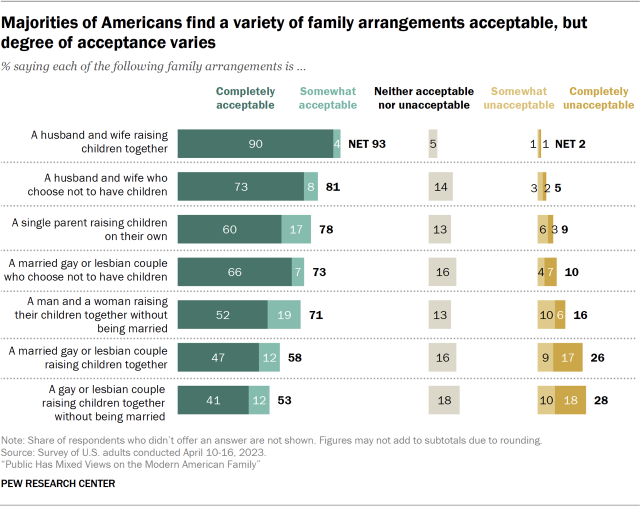
Women are more likely than men to say several family types are acceptable, including a husband and wife who choose not to have children, a single parent, and a married or unmarried gay or lesbian couple raising children.
Opinions also vary by race and ethnicity, age, marital status, sexual orientation, and partisanship.
Race and ethnicity
While the vast majority of adults say a husband and wife raising children together is acceptable, White adults are the most likely to say this. White adults (84%) are also more likely than Black (75%), Hispanic (78%) and Asian adults (76%) to say a husband and wife who choose not to have children is acceptable.
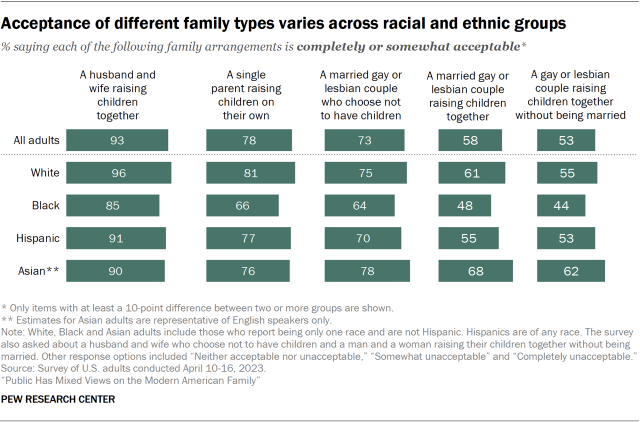
There are wider differences among racial and ethnic groups when it comes to assessments of single parents and gay or lesbian couples with or without children. About three-quarters or more among White (81%), Hispanic (77%) and Asian adults (76%) say a single parent raising children on their own is an acceptable type of family. Some 66% of Black adults say the same.
White and Asian adults are more likely than Black and Hispanic adults to say most family arrangements for gay or lesbian couples asked about are acceptable. For example, 68% of Asian adults and 61% of White adults say a married gay or lesbian couple raising children is acceptable. This compares with 55% of Hispanic and 48% of Black adults. White, Hispanic and Asian adults are more likely than Black adults to say a gay or lesbian couple raising children together without being married is acceptable.
Age
Across age groups, younger adults are more accepting than older adults when it comes to families involving gay and lesbian couples. For example, 73% of 18- to 29-year-olds say a married gay or lesbian couple raising children together is acceptable, compared with 60% of those ages 30 to 49, and about half of those 50 and older.
Adults under 50 are more likely than those ages 50 and older to say an unmarried man and woman raising children is an acceptable arrangement (76% vs. 66%).
Marital status
Views of family arrangements differ by marital status. Unmarried adults who are living with a partner are the most likely to say an unmarried man and woman raising children together is acceptable: 87% say this. By comparison, 66% of married adults say the same, as do 78% who have never been married.
Similarly, three-quarters of unmarried adults living with a partner say a married gay or lesbian couple raising children is acceptable. This compares with 54% of married adults and 68% of those who have never been married.
Sexual orientation
Lesbian, gay or bisexual adults are more likely than straight adults to say all of these types of families are acceptable. The one exception is a husband and wife raising children together, which the vast majority of all adults say is acceptable.
Not surprisingly, this is especially the case in views of gay and lesbian couples. While 90% of lesbian, gay or bisexual adults say a married gay or lesbian couple who choose not to have children is acceptable, 71% of straight adults say the same. Similarly high shares of lesbian, gay or bisexual adults say a married (89%) or unmarried (88%) gay or lesbian couple raising children together is acceptable. Smaller shares of straight adults say the same for each (55% and 50%, respectively).
Partisanship and ideology
Apart from a husband and wife raising children together, which an overwhelming majority in both parties find acceptable, there are double-digit differences in the shares of Democrats and Republicans who say the other family types are acceptable.
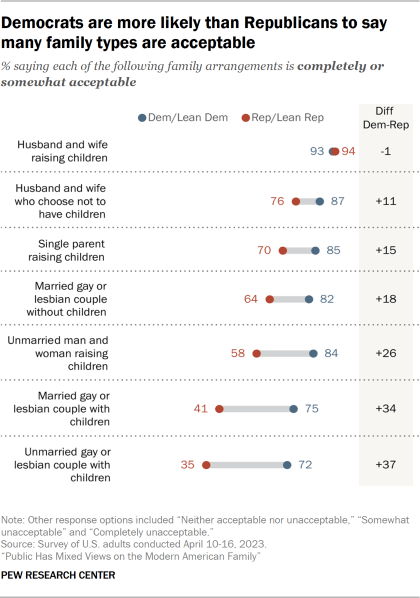
For example, there is a difference of 37 percentage points between the 72% of Democrats who say an unmarried gay or lesbian couple raising children together is acceptable and the 35% of Republicans who say the same.
And while majorities of both Republicans and Democrats say an unmarried man and woman raising children together is acceptable, Democrats are much more likely than Republicans to hold this view (84% vs. 58%).
There are also differences among Democrats and Republicans across the ideological spectrum on views of different family types.
For most types of families apart from a husband and wife raising children together, conservative Republicans are the least accepting. In turn, liberal Democrats are the most accepting. Moderate and liberal Republicans and moderate and conservative Democrats have quite similar views about many family types.
For example, 50% of conservative Republicans say an unmarried man and woman raising children together is acceptable. This compares with 73% of moderate and liberal Republicans, 78% of conservative and moderate Democrats, and 92% of liberal Democrats who say the same.
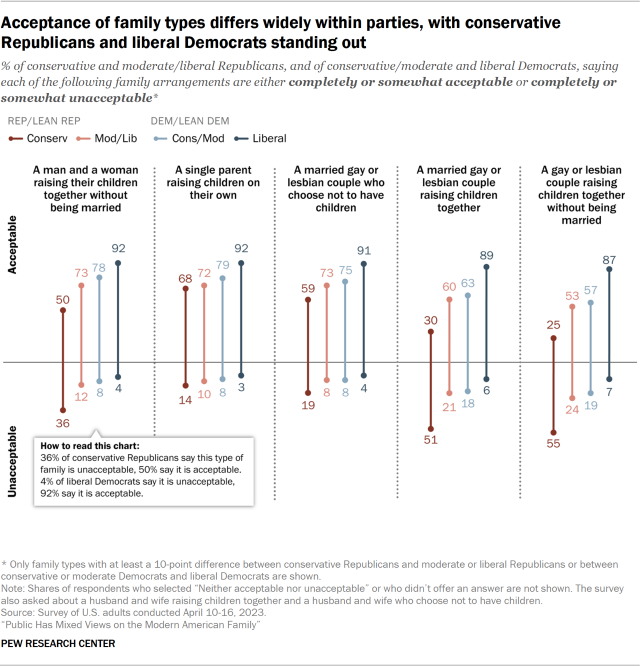
The differences are even more striking when looking at views of families that include gay and lesbian couples. There is a 30-point difference between the share of conservative Republicans and the share of moderate and liberal Republicans who say a married gay or lesbian couple raising children together is acceptable. Among Democrats, there is a 26-point difference between conservatives and moderates in the party and liberals who say these families are acceptable.
Factors that shape views of family
The survey also asked about what factors have influenced Americans’ views of what makes a good family arrangement. By far the biggest influence is a person’s experiences with their own family growing up. About seven-in-ten adults (68%) say this has influenced their views of what makes a good family a great deal or a fair amount.
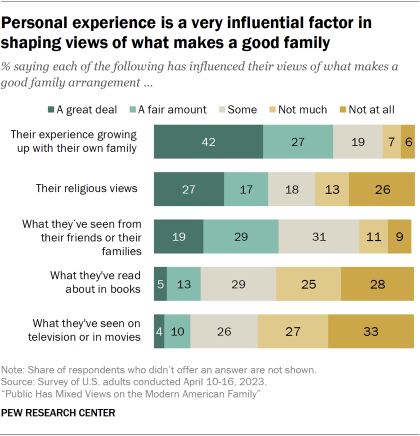
About half (49%) say what they’ve seen from their friends or their friends’ families has had at least a fair amount of influence, and 43% point to their religious views.
Smaller shares say what they’ve read about in books (18%) or what they’ve seen on television or in movies (14%) has had a great deal or a fair amount of influence on their views.
Experiences growing up are the dominant influence across most major demographic groups, with some important differences by age, sexual orientation and religion.
Age
Adults ages 65 and older are the most likely to say their families growing up and their religious views have had at least a fair amount of influence on their views of what makes a good family.
In turn, adults younger than 30 are the most likely to say what they’ve seen on television or in movies has had this amount of influence.
Sexual orientation
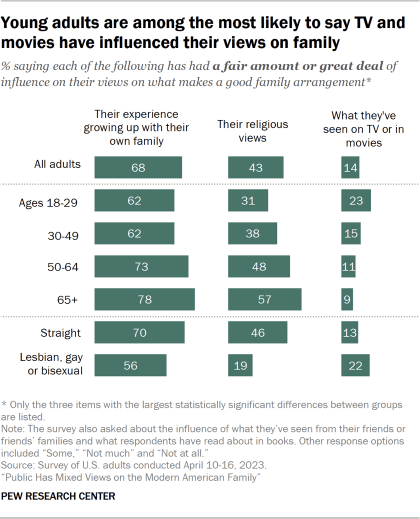
Lesbian, gay or bisexual adults are more likely than straight adults (22% vs. 13%) to say what they’ve seen on television or in movies has had a fair amount or a great deal of influence on their views of good types of families. This difference remains even when considering the fact that lesbian, gay or bisexual adults tend to be younger than straight adults.
In turn, straight adults are more likely than lesbian, gay or bisexual adults to say their experience growing up with their own family (70% vs. 56%) and their religious views (46% vs. 19%) have had at least a fair amount of influence on their views of good types of families.
Religion
White evangelical Protestants are much more likely than other groups to cite their religious beliefs as an influence on their views about what makes a good family arrangement. Fully 83% say religion has at least a fair amount of influence on these views, compared with 48% of White non-evangelical Protestants, 62% of Black Protestants and 47% of Catholics. Just 12% of religiously unaffiliated adults say this about their religious beliefs.




